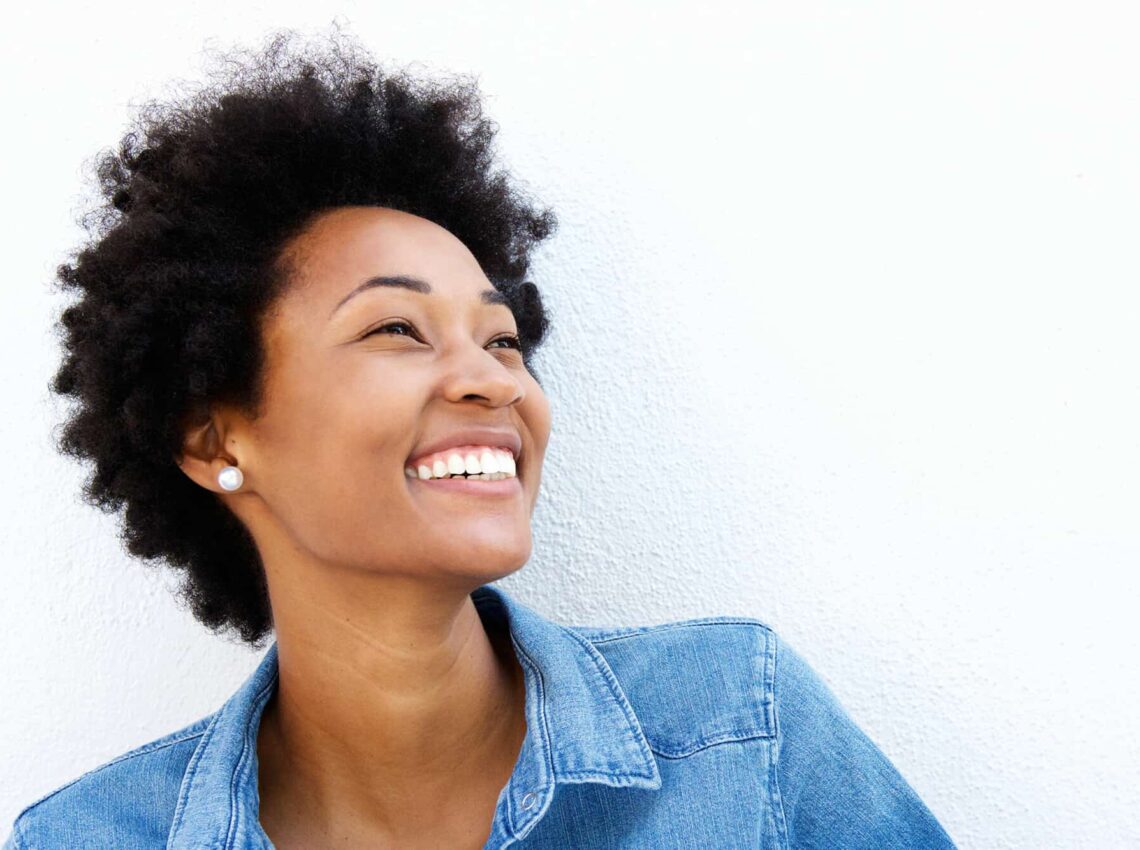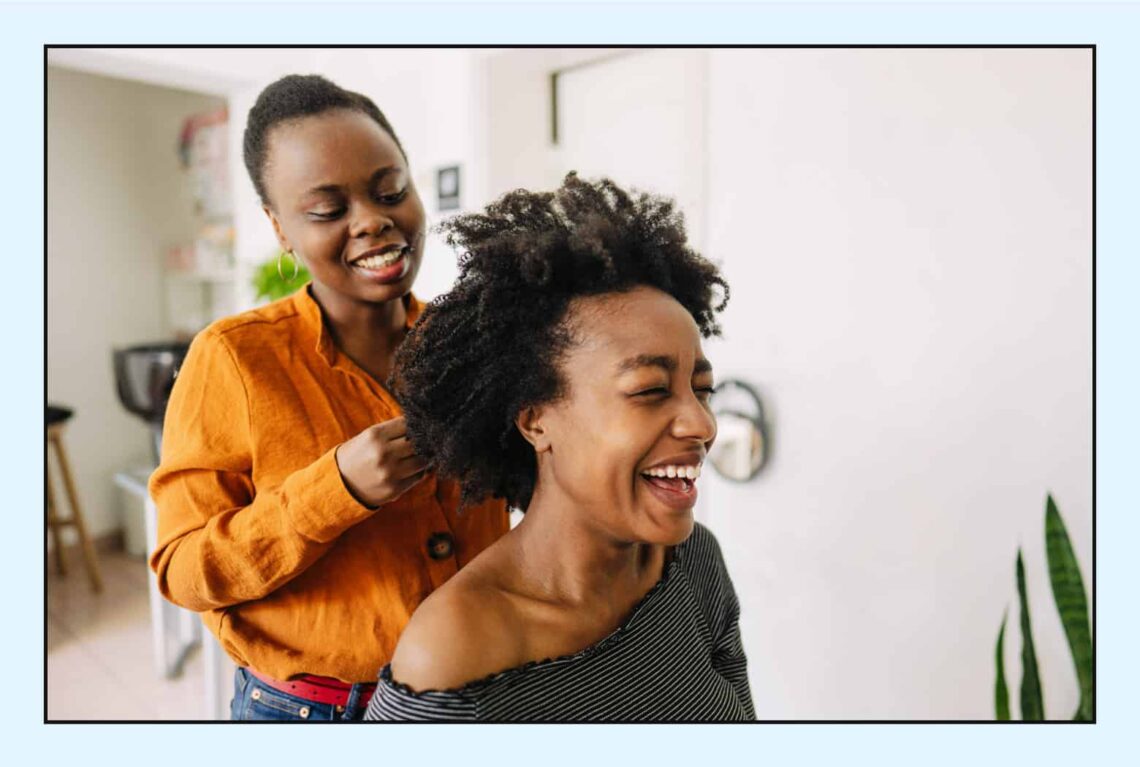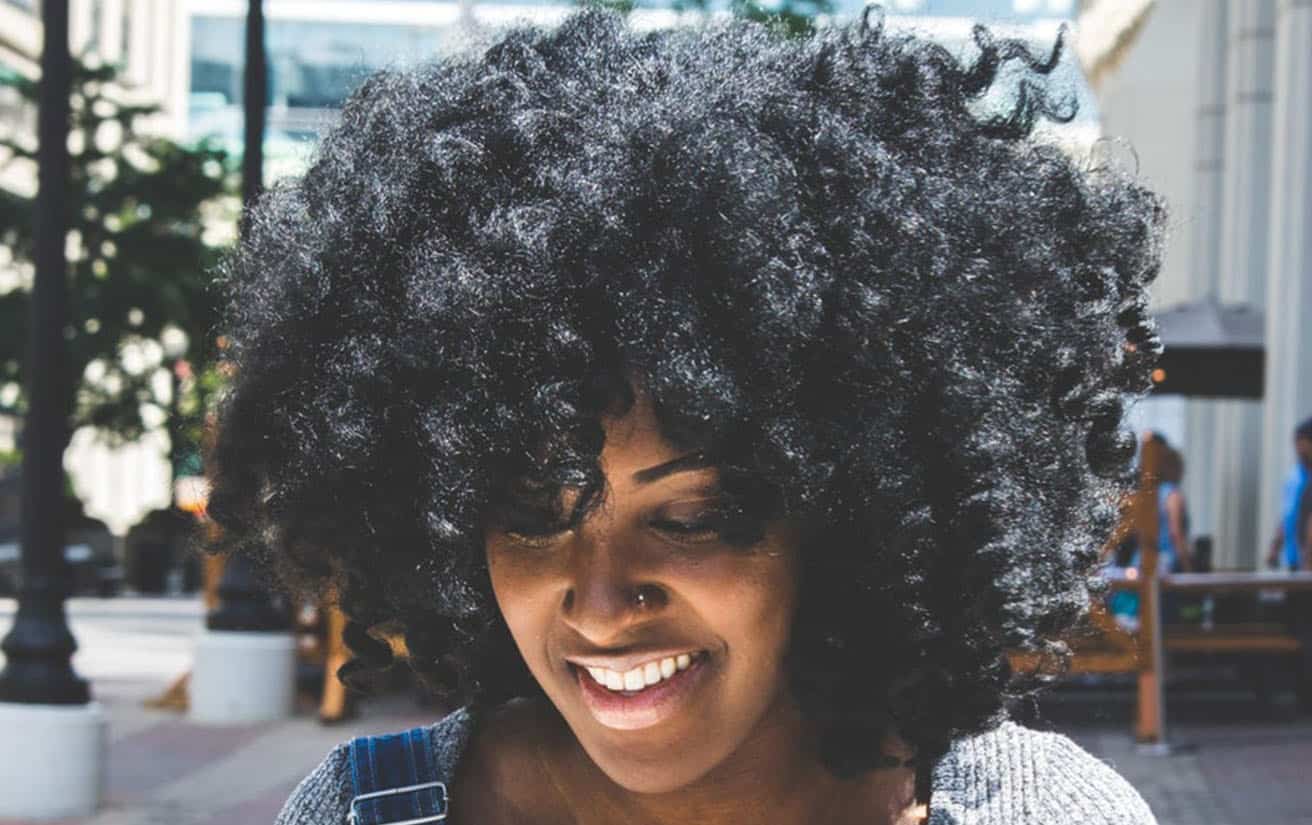Natural Hair: Your Expert Guide

Embracing your natural hair is a journey and your natural curls deserve to be celebrated. Caring for natural hair comes with some trial and error, especially in the beginning. Whether you’ve been natural for a while or you’re just getting started, we’ve put together this guide to answer some common questions on natural hair care. We’ll also go over some of the history of natural hair and offer some tips for caring for your natural hair.
What Is Natural Hair?
Natural hair is typically known as hair that hasn’t been chemically straightened, curled, colored, or hasn’t undergone anything else that changes the natural state of the hair. The term is used to normally refer to the hair of people in the Black community.
Textures can range from curly to coily and many in the community have multiple hair textures. Some even have straight hair. There’s a lot of history and symbolism with natural hair that we’ll go into next.
A Brief History on Natural Hair
Over the years, the Black community has been discouraged to wear their natural hair for many reasons. Prior to slavery in the 1400s, Africans wore intricate hairstyles to signify things like tribe and rank. When Europeans came to enslave Africans, their heads were shaved. Europeans claimed it was for sanitary reasons, but doing so stripped Africans of their identity and the connection to their home.
The attack on natural hair continues past slavery. Former Louisiana governor Rodriguez Miró passed the Tignon Laws in 1786 that required women of color to cover their hair with a tignon headcovering. This was done to stop non-white women from wearing elaborate and regal hairstyles, and was also meant to visually subordinate them. The Tignon Laws were no longer enforced in 1803 when the United States made the Louisiana Purchase.
Wearing natural hair became more popular in the 1960s during the Civil Rights Movement. People in the Black community were encouraging each other to wear their hair naturally, embrace their natural features, and to move away from copying Eurocentric standards of beauty.
The natural hair movement had another resurgence in the 2000s when more and more people opted to wear their hair naturally. Although this is great progress, discrimination against natural hair is far from gone. There are still people who hold the racist notion that natural hairstyles are unprofessional.
Thankfully, organizations like the Curly Girl Collective are working to undo the false narrative surrounding natural hair and to help everyone embrace their natural curls.
How Are Hair Textures Related to Natural Hair?
Knowing your natural hair textures helps you understand how to care for it. Most people have multiple hair textures, so you may need different products and care routines for each one.
These are the four hair textures: type 1 (straight), type 2 (wavy), type 3 (curly), and type 4 (coily or kinky). You may hear about other names and categories since some stylists have created their own classification systems. However, mislabeling the names of your hair types won’t make or break your hair care routine.
A general understanding is enough to help you find the hair products you’ll need to keep your hair healthy and achieve certain styles. For example, curly and kinky hair need more moisturizing products than straight hair. This is because the hair’s natural oils more easily travel down straight hair than curly and kinky hair.

What Are Some Popular Natural Hair Styles?
Braids and twists are popular styles that both look great and protect your natural hair. Weaves, wigs, and headscarves are other popular options for natural hair.
Protective styling is especially important if you’re transitioning your hair. Styles like braids help your hair grow by keeping your ends safe, your hair protected from the elements, and are typically easy to maintain.
Other popular natural hairstyles that show off volume and length include twist outs, braid outs, blow outs, puffs, and many half-up, half-down styles. Many people like to go with the big chop to start fresh on their natural hair journey. The big chop cuts off damaged hair and gives you a fresh start.
You don’t need to get a big chop to go natural, but it can help your hair grow back healthier and stronger. It’s also a great choice if you’ve used lots of relaxers and other products in your hair. Don’t worry about the length. There are plenty of beautiful short styles for natural hair you can try.

How Do You Treat Natural Hair?
You’ll need to use a combination of hair products and styling methods to keep your natural hair healthy and protected. What works for your bestie might not work for you, so you’ll need to try out at least a few products to see what works best for your hair. We’ll go over some tips below for different ways to care for your natural hair.
Shampooing Tips
It’s important to keep your hair clean, but too much washing can strip your hair of its natural moisture and damage it. We’re going to dive into some tips on washing your natural hair while keeping it healthy.
- Pick a gentle shampoo. Ingredients like sulfates and parabens can be especially harsh on natural hair. Sulfate-free shampoos can gently clean your hair without stripping your natural oils or introducing questionable chemicals to your hair.
- Avoid over-washing. Clean hair is important to keep it healthy. However, over-washing can have the opposite effect and leave your hair dry and dull. Space out your wash days and test what schedule works best for your hair. If needed, you can look into co-washing or dry shampoos to keep your hair clean in between wash days.
- Try a pre-poo. Pre-poo is a treatment you work into your hair before washing or conditioning your hair. It helps detangle, soften, and nourish your hair. You can buy pre-poo treatments online or at your local beauty store. You can also make your own treatment at home.
- Section your hair. If you have long or thick hair, it may be easier to wash your hair in sections. Braid or twist your hair into a few sections and wash them one by one.
- Use clarifying shampoo once in a while. Your hair is going to get heavy with product build up as you try different moisturizers and treatments. Clarifying shampoos get rid of product build up, dust, and other things your regular shampoo can’t wash out. Pick clarifying shampoo that’s meant for your hair texture. Sulfate-free clarifying shampoo and others with moisturizing ingredients are also great for natural hair.
Conditioning Tips
Conditioner is a must for natural hair. Normal conditioner during your wash day routine and other conditioning products keep your hair healthy and moisturized. They also help keep your hair shiny and prevent damage. We’ll go over some tips to keep your hair conditioned.
- Wash your hair first with warm water. Warm water opens up your hair cuticles so it can more easily absorb your conditioner.
- Focus on your ends. Your ends are the driest part of your hair and need the most moisture.
- Don’t over condition your hair. Over conditioning can happen if you condition too often, don’t thoroughly rinse out the conditioner, and a number of other reasons. You’ll end up with limp hair that’s difficult to style.
- Rinse your hair well with cold water. Unless you’re using a leave-in product, rinse out your conditioner as directed. Cold water closes your cuticles to help lock in moisture.
- Find a good sealant. A hair sealant is an oil or butter that seals moisture. Use this after deep conditioning.
- Regularly apply a deep conditioner. Depending on how dry your hair is, you may want to use a deep conditioner every few weeks. A deep conditioner nourishes and refreshes your hair. A leave-in conditioner is another option you can use instead of or in combination with a deep conditioner.

Breakage and Shedding Prevention Tips
Breakage and shedding are different issues. Shedding is a part of the normal hair cycle. We all shed about 50 to 100 hairs a day. If you have excessive shedding or hair loss, it can be a result of lots of things ranging from medication, diet, and stress. However, all hair will eventually shed and fall off.
Breakage is not natural and it’s normally a result of excessive heat styling, over manipulation, over washing, and depriving your hair of nutrients. You can tell the difference by looking at the hair that falls out. If it’s a full strand with the root at the bottom (that looks like a white bulb), then you’re experiencing shedding. If you find shorter hairs with the root, then you’re experiencing breakage.
Proper washing and conditioning are just a couple of ways you can prevent breakage and excessive shedding. We have a few more tips you can do to protect your hair from breakage.
- Detangle hair before you wash. Hair is weaker when it’s wet, so you may cause breakage if you try to detangle your hair after your shower. Experiment with detangling with your fingers, combs, and brushes to find what works best.
- Pick a hair drying method. Many Pros recommend air drying your hair since it’s least likely to damage your hair. However, you can still use a hair dryer as long as you take some steps to protect your hair. You should use a heat protectant on your hair and keep your tools on the lowest heat setting. When blow drying your natural hair, opt for a diffuser to more evenly distribute heat.
- Say “no” to cotton towels. Normal terry cloth towels can give you frizz and may cause breakage. Microfiber towels and T-shirts are gentler on your hair. Don’t rub your hair when you’re drying with a towel. Instead, wrap your hair and squeeze out excess moisture.
- Take a break from tight styles. Tight braids and buns look great, but can be a source of shedding. Pay attention to how much you shed the next time you take down your hair from a tight style. If you’re noticing more hair or lots of split ends, then it may be time to try a new look.
- Be gentle with your hair. Handling your hair with care when you wash, condition, style, and detangle lessens the chance of breakage. Take your time when you’re working with your hair.
- Get regular haircuts. Cutting off damaged hair is the best option once your hair is damaged. You can take steps to prevent further damage and make currently damaged hair easier to style, but you can’t reverse damage done on hair.
- Be careful with heat. Using heat tools often can dry out and weaken your hair. We’ll go into specific tips later on, but just know that you should take steps to protect your hair when you use heat.
- Try a protein treatment. Protein treatments strengthen hair by adding hydrolyzed proteins to the cuticle and hardening hair. It’s great if you notice your hair is losing its natural curl, it’s flat, or you’re noticing some excessive shedding. You can find treatments at your local beauty salon and DIY recipes online. However, we recommend chatting with your stylist first for advice on products and recipes. A Pro can also do this treatment for you.
Nutrition and Supplements Tips
There are lots of beauty supplements, powders, programs, and many other things that are on the market. The question is — do you need them? Probably not, but that depends a lot on your lifestyle and existing medical conditions.
The best things you can do for your hair are things you should already be doing: keeping stress levels down, getting enough sleep, staying hydrated, and eating balanced meals. You can stretch out your natural hair every once in a while if you’d like to see how much it’s grown.
Your healthcare provider is the best person to advise you on supplements and other lifestyle changes to help your hair growth. We’ll give some general tips to keep in mind, but we recommend giving your doctor a call before you plan on taking any new supplement or regimen.
- Lessen your stress. Hair loss and stress are related. Lots of hair can fall out of your head or you may develop an urge to pull out your hair. The best thing you can do now is focus on reducing stress. Say “no” when you don’t want to do things, take breaks when you’re at work, and see a doctor if you feel like something isn’t right.
- Get some rest. Lack of sleep is closely related to stress. Avoiding sleep deprivation is crucial for your overall health, as well as the vitality of your hair.
- Stay hydrated. Believe it or not, hydration affects your hair. Keep yourself hydrated by regularly drinking water to help your body and hair.
- Eat a balanced diet. A healthy diet is different for everyone based on specific needs and lifestyle factors. Incorporating fruits, veggies, and nutritious food into your diet helps you feel better and keeps your hair strong. Ask your healthcare provider for advice on food and if you should consider supplements.

Can You Use Heat On Natural Hair?
Yes, you can safely use heat on natural hair as long as you take the right precautions. Using low heat and using it less often can minimize damage. Heat protectants are an extra step to minimize damage from hot styling tools. The more you avoid heat on your hair, the less likely you are to damage it.
Can You Texturize Natural Hair?
You can texturize your natural hair if you want to relax your curls a little bit. A texturizer is a lighter version of a relaxer. It’ll relax your curls without making your hair completely straight. You also only need to leave it in for about five to 10 minutes.
However, this is still a chemical treatment. Although it’s meant to be gentler than a relaxer, it can still damage your hair. Your hair may not react to the chemicals the way you expect. We recommend going to a Pro so they can pick out the right products for your hair, answer your questions, and apply it for you. This will help you avoid damaging your hair or scalp by texturizing your hair at home.
It’s important to keep your hair healthy after using a texturizer. You’ll just need to keep up with your moisturizing and hair care routine. If you want to start fresh, you’ll need to cut off texturized hair. Remember, since texturizer uses chemicals, your hair won’t be 100 percent natural.

Can You Safely Color Natural Hair?
Yes, you can safely color your natural hair as long as you take some precautions. First, you’ll need to understand how your hair type affects hair coloring since hair color has to do more with porosity than texture. Porosity is your hair’s ability to absorb moisture. Curly and kinky hair is more porous, so they take in color faster than less porous hair types.
Permanent and demi-permanent hair color needs to penetrate your hair cuticle to deposit the color. This can create issues for highly porous hair. Porous hair more easily open to absorb color, but may not close back tight enough to retain moisture. This means that using highly moisturizing products and regular deep conditioning is essential when adding color to natural hair.
Other hair color maintenance tips also apply if you want to maintain your color. Using color-safe hair products, reducing heat styling, limiting hot showers, and washing your hair less often are things you’ll need to incorporate into your regular hair routine.
Natural hair is beautiful and everyone has their own ways of caring for it and showing it off. If you’re starting your natural hair journey or have a few questions, we recommend visiting a natural hair Pro in your area. They can give you tips for styling and caring for your hair.
Sources: History | NaturAll Club | Kika Curls | JSTOR


